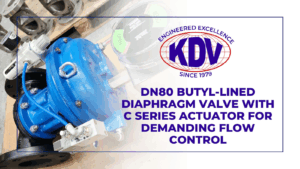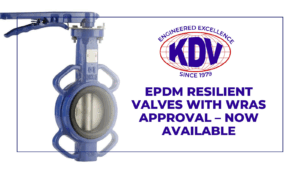Stainless Steel Diaphragm Valves: A Growing Trend in Industrial Applications
Last week highlighted the rising demand for stainless steel diaphragm valves across various industrial sectors. Nearly every order assembled and tested at our UK facility featured stainless steel components, including a recent shipment of 29 DN25 Weir Type valves with GR97 (PTFE/Viton) diaphragms, ready to meet the exacting requirements of our clients.
Since introducing our stainless steel diaphragm valve range at KDV Flow, we’ve seen a global industry shift towards these valves in a broad range of applications. Initially, stainless steel valves were used primarily in aseptic environments, such as pharmaceuticals and food processing. However, their exceptional durability, corrosion resistance, and adaptability have expanded their use to industries like chemical processing, water treatment, and more. This trend is driven by the need for equipment that can reliably withstand aggressive chemicals, extreme temperatures, and harsh conditions, while offering extended service life and reduced maintenance costs. This trend is also influenced by stricter industry regulations requiring high-purity and contamination-free fluid handling solutions.
Benefits of Stainless Steel Diaphragm Valves:
- Superior Corrosion Resistance: Stainless steel’s natural resistance to corrosion makes it ideal for handling aggressive chemicals, caustic substances, and exposure to harsh environments, ensuring reliable performance and longer equipment life. In industries such as marine applications and wastewater treatment, this corrosion resistance significantly reduces the risk of premature valve failure.
- Enhanced Durability: With robust construction and the ability to withstand both high pressures and extreme temperatures, stainless steel valves offer extended operational lifespans and fewer maintenance requirements, reducing downtime and lowering costs. Compared to plastic or brass alternatives, stainless steel diaphragm valves perform better in high-temperature steam applications and chemically intensive processes.
- Versatility in Customisation: Our stainless steel diaphragm valves can be customised with a variety of linings—such as PTFE, EPDM, or rubber—to enhance chemical compatibility for specific applications. Additionally, we offer a wide range of actuation options, including pneumatic, electric, and manual, to meet diverse operational needs. This flexibility makes them suitable for applications requiring precision flow control, such as dosing and metering in pharmaceutical manufacturing.
- Wide Range of Applications: From chemical processing to pharmaceutical production and food and beverage manufacturing, stainless steel diaphragm valves are trusted for their reliability and adaptability. For example, in pharmaceutical production, these valves maintain sterility and prevent contamination, while in chemical plants, they handle aggressive, corrosive substances without compromising performance. Moreover, their role in semiconductor manufacturing is growing, as ultra-pure water systems demand high-precision, contamination-free valve solutions.
Addressing Key Industry Questions:
- What are the two types of diaphragm valves? Diaphragm valves are classified into weir-type and straight-through (full bore) designs. Weir-type valves are better suited for sanitary applications, while straight-through valves are preferred for slurry and high-viscosity media handling.
- Are stainless steel valves worth it? Yes, stainless steel diaphragm valves offer long-term cost savings due to their durability, corrosion resistance, and minimal maintenance requirements. Their higher initial cost is offset by their extended service life and superior reliability in demanding environments.
-
What is the life expectancy of a diaphragm valve? The lifespan varies depending on usage conditions, but high-quality diaphragm valves can last 10–20 years with proper maintenance. Factors such as operating temperature, pressure, and media type influence longevity, making material selection crucial.
-
What is the disadvantage of a diaphragm valve? While highly effective, diaphragm valves have limitations in high-pressure applications and may require periodic diaphragm replacements. Additionally, they are not ideal for handling extremely viscous or particulate-laden fluids, as these can cause wear on the diaphragm material.
FAQS for using Stainless Steel Diaphragm Valves
How do stainless steel diaphragm valves compare to plastic diaphragm valves in terms of longevity and performance?
Stainless steel diaphragm valves provide superior durability, temperature resistance, and chemical compatibility compared to plastic variants, which may degrade faster under extreme conditions. While plastic valves are cost-effective for low-pressure applications, stainless steel options offer better structural integrity, making them ideal for high-pressure, high-temperature, and aggressive chemical environments.
What factors influence the selection of diaphragm materials in stainless steel diaphragm valves?
The choice of diaphragm material depends on chemical compatibility, temperature range, pressure conditions, and cycle frequency. For example, PTFE diaphragms are preferred for highly corrosive media, EPDM is used for sanitary applications like pharmaceuticals and food processing, while rubber-lined diaphragms offer improved flexibility and abrasion resistance in slurry handling.
How does the surface finish of stainless steel diaphragm valves impact hygiene and contamination control in aseptic applications?
In industries like pharmaceuticals and food processing, a high-purity, electropolished surface finish (typically Ra ≤ 0.4 µm) is essential to prevent microbial growth and ensure easy cleaning (CIP/SIP compatibility). Surface roughness influences fluid adherence, biofilm formation, and overall process sterility, making material finish a key factor in valve selection.
What are the challenges of automating stainless steel diaphragm valves in high-cycle process systems?
When automating high-cycle diaphragm valves, engineers must consider actuator type (pneumatic/electric), response time, sealing integrity, and wear resistance. High-frequency cycling can cause diaphragm fatigue, requiring precision-engineered actuation and position feedback systems to maintain accuracy and extend the valve’s lifespan.
How does temperature cycling affect the performance and sealing properties of stainless steel diaphragm valves?
Frequent temperature fluctuations can impact diaphragm elasticity, sealing effectiveness, and overall valve integrity. In applications with extreme thermal cycling (e.g., steam sterilisation or cryogenic processes), material expansion/contraction must be accounted for, and reinforced diaphragms or secondary sealing mechanisms may be necessary to prevent leaks.
KDV Flow’s Commitment to Quality
At KDV Flow, we are dedicated to delivering high-quality stainless steel diaphragm valves that meet the stringent requirements of modern industrial processes. Each valve is precision-engineered using advanced CNC machining and automated assembly techniques, ensuring consistent product quality. Every valve undergoes rigorous testing, including pressure and function testing, to guarantee optimal performance and reliability under the toughest conditions. Furthermore, our compliance with global industry standards, including ISO and FDA certifications, ensures that our valves meet regulatory requirements across different sectors.
Experience the KDV Difference
If you’re seeking reliable, efficient, and long-lasting flow control solutions, look no further than KDV Flow. Our stainless steel diaphragm valves offer unmatched durability, corrosion resistance, and versatility, making them the ideal choice for a wide range of industrial applications.
Contact us today to request a quote or schedule a consultation to discuss your specific requirements. Discover how KDV Flow can enhance the performance of your operations with precision-engineered valve solutions. Contact our team today for expert guidance on selecting the best diaphragm valve for your specific needs.


